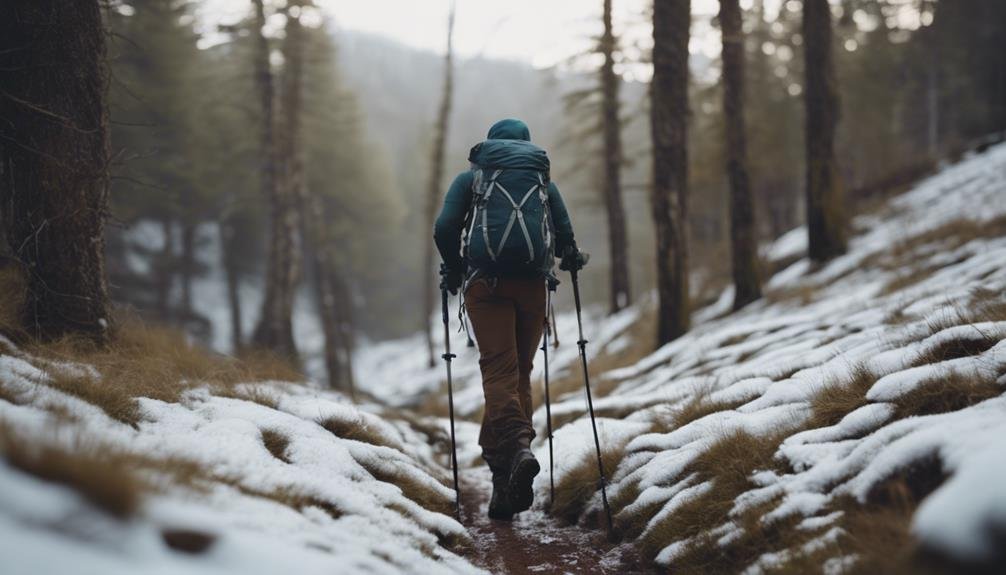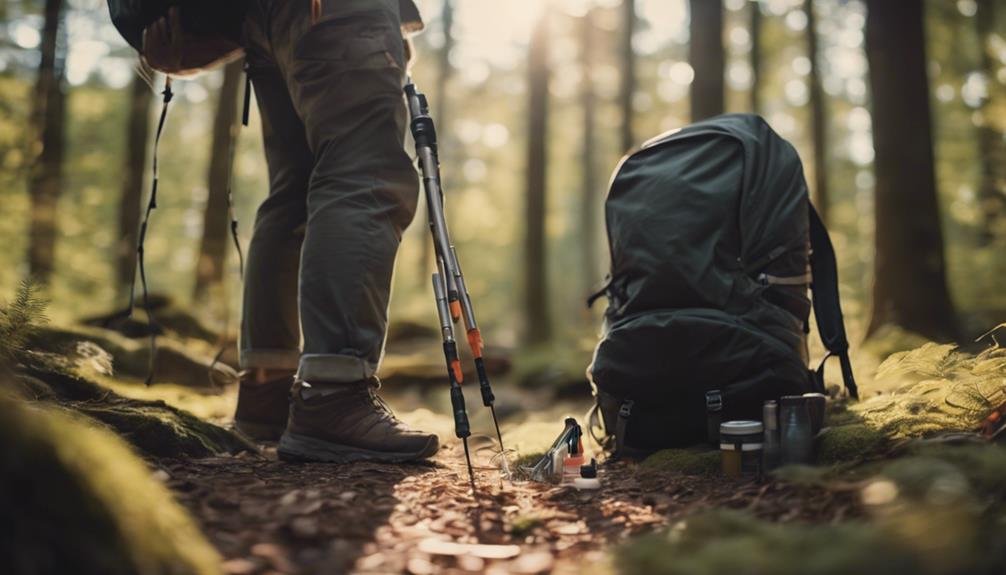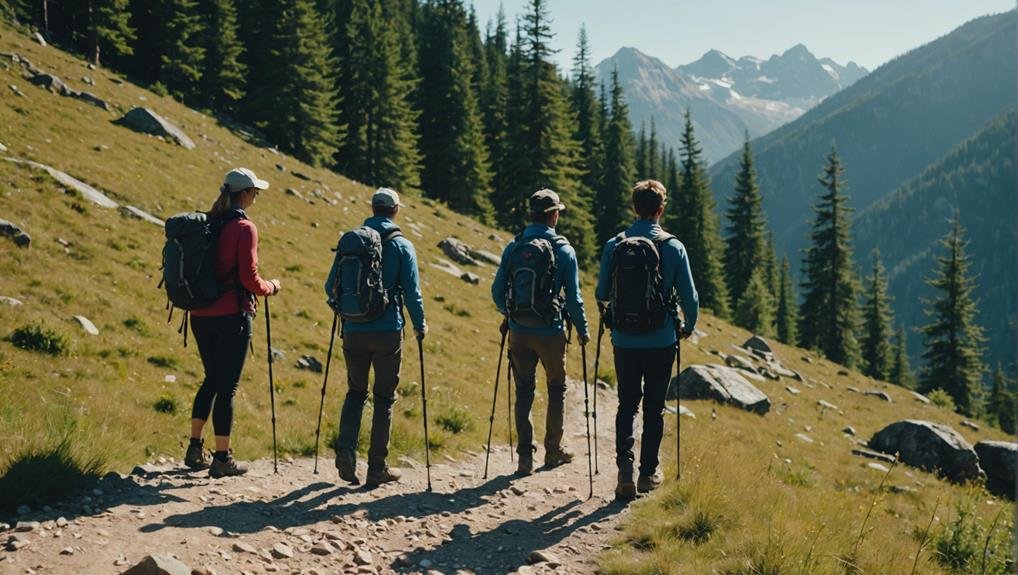You’ve probably seen hikers using trekking poles on the trails and wondered if they’re really necessary. Well, they’re not just for show; these tools can greatly reduce the impact on your knees, especially during descents, and improve your balance on uneven terrain. When selecting the right trekking poles, you’ll want to take into account factors such as weight, adjustability, and grip comfort. But there’s more to using these poles than simply picking them up and walking. If you’re curious about how to adjust them properly for different terrains, or why the ‘plant and push’ technique could revolutionize your hiking experience, you’ll find that a deeper understanding of these tools can transform your adventures.
Key Takeaways
- Trekking poles enhance stability and reduce joint wear, crucial for uneven and challenging terrains.
- Adjustable telescopic poles allow for optimal performance by matching the pole length to the terrain.
- Lightweight carbon fiber poles offer durability without adding extra weight, ideal for long hikes.
- Using proper techniques like ‘plant and push’ and ‘braking’ can improve efficiency on uphill and downhill paths respectively.
- Regular maintenance, such as cleaning and checking for wear, ensures poles remain reliable and safe.
Benefits of Trekking Poles
When hitting the trails, incorporating trekking poles can greatly enhance your stability and reduce the wear on your joints. By using poles, you’re not just walking; you’re guaranteeing a more secure and efficient hike. Trekking poles provide vital support on uneven terrain, where the risk of slips and falls increases. They function as additional points of contact with the ground, which distributes your body weight more evenly. This not only improves your balance but also safeguards your knees and joints from the harsh impacts typically experienced during challenging hikes.
Moreover, trekking poles contribute to your endurance on long trails. They allow you to engage your arms and shoulders, helping to propel you forward and take some of the burdens off your legs. This distributed effort can prevent muscle fatigue and keep you going for longer periods. Additionally, maintaining a consistent pace becomes easier as the poles help establish a rhythmic pattern of movement. This rhythm not only enhances your walking efficiency but also ensures that you expend your energy more evenly throughout the hike. With poles, you’ll find that you can tackle longer distances with increased confidence and comfort.
Choosing the Right Poles
Selecting the right trekking poles is essential, as they must match the specific demands of your hiking terrain and personal needs. When choosing the right poles, you’ll first want to take into account the type of terrain you’ll be trekking on. Telescopic poles offer adjustable lengths which are ideal for uneven terrain, whereas folding poles provide a compact option for smoother trails.
Opt for lightweight carbon fiber poles for their durability without adding significant weight to your gear. This material choice is important as it balances strength and comfort during long hikes. Additionally, if you’re concerned about the impact on your joints, look for poles with a shock-absorbing feature. These can greatly reduce the strain on your knees and ankles, enhancing your endurance.
Don’t overlook the importance of wrist straps and grip quality in your trekking poles. Proper wrist strap support ensures that you maintain a good hold without straining your hands, which is crucial for long treks. The grip should be ergonomically designed to fit comfortably in your hand, providing stability and control as you navigate through various terrains.
Using Poles on Various Terrains

Trekking poles transform your hiking experience, providing essential support and stability across various terrains, from steep ascents to flat trails. When you’re faced with uphill terrain, using trekking poles gives you an extra boost. They allow you to engage your upper body muscles actively, helping to distribute your weight more effectively and sparing your legs from bearing all the burden. This not only increases your power but also enhances endurance, allowing you to tackle those challenging slopes with less fatigue.
On flat ground, trekking poles aren’t just vital tools. They guide your movements, mimicking the natural arm swing you employ while running, which improves your walking efficiency. This rhythmic motion helps maintain a steady pace and reduces the energy expenditure over long distances.
Descending on downhill terrain, however, is where trekking poles truly excel. They aid in maintaining balance and reduce the impact on your joints. Proper grip and technique in these situations are essential—they help you control your momentum and manage your speed with precision, preventing undue stress on your knees and hips.
Adjusting Your Trekking Poles
To optimize your performance and comfort on the trail, you’ll need to adjust your trekking poles to the right length for your height. Most poles feature adjustable mechanisms to fine-tune their length, ensuring they’re perfectly matched to your body and hiking conditions. This is important as the correct pole length is instrumental in maintaining proper posture and reducing strain on your joints.
When setting the length, a good rule of thumb is that your elbows should be at about a 90-degree angle when you hold the poles with tips on the ground near your feet. This position helps maintain proper posture, which is crucial for efficient movement. Incorrect pole length can lead to slouching or overextension, both of which can cause discomfort and increase fatigue during your hike.
Furthermore, properly adjusted trekking poles can greatly enhance stability, especially on uneven terrain. They act as additional points of contact with the ground, improving your balance and distributing your body weight more evenly. This not only helps in conserving energy but also increases your endurance, allowing you to tackle longer or more challenging trails with greater ease.
Maintenance and Care Tips

Proper maintenance and care of your trekking poles not only extend their lifespan but also guarantee peak performance on your hikes. To begin, always clean and dry your poles after each use. This simple step prevents corrosion and maintains durability, important for the longevity of your equipment.
Regularly checking for wear or damage is essential. Inspect your poles for any signs of stress or breakage, especially after rigorous hikes. This ensures you won’t be caught off guard by a malfunctioning pole when you’re relying on them the most.
Don’t forget to tighten adjustable mechanisms before each hike. Loose parts can lead to slippage, potentially causing instability or injury. Making sure everything is secure enhances safety and improves usability.
Also, remember to replace worn-out tips to maintain ideal traction and grip. Trekking poles are your contact point with the ground, and effective tips are crucial for handling varied terrains confidently.
Lastly, store your trekking poles in a cool, dry place. Proper storage prevents unintended damage and keeps your poles ready for your next adventure. By following these guidelines, you’ll ensure that your trekking poles are always ready when you are.
Why are Trekking Poles Essential for Hiking?
Trekking poles are essential for hiking because they provide stability and support, especially on challenging terrain. They help distribute weight and reduce strain on the body, making long hikes more enjoyable. Whether it’s a leisurely stroll or a challenging trek, using trekking poles can improve your overall hiking experience. Catch the buzz at SRP Park and make the most of your hiking adventures.
Advanced Trekking Pole Techniques
Now that you’ve mastered the basics of maintaining your trekking poles, let’s explore some advanced techniques to enhance your hiking efficiency and safety. When you hit the trail without mastering these skills, you mightn’t make the most of your hiking poles.
Firstly, adopt the ‘plant and push’ method for effective uphill climbing. This involves planting your poles firmly in the ground and using them to propel yourself upwards, reducing the strain on your legs. This technique not only conserves energy but also increases your climbing speed.
For downhill descents, practice the ‘braking’ method. By placing your poles slightly ahead and using them to control your descent, you minimize the impact on your knees and maintain a steady pace, even on slippery slopes.
On uneven terrain, the ‘cross-body reach’ technique can be a game-changer. Reach across your body with one pole for greater stability and balance, ensuring a safer passage through tricky sections.
In more challenging trail sections, the ‘double plant’ method offers added support. Plant both poles before making a steep or unstable step to distribute your weight evenly and increase power.
Lastly, the ‘pole vaulting’ technique allows you to navigate over obstacles smoothly, maintaining your momentum without missing a beat. These advanced trekking pole techniques are essential for any serious hiker.
Conclusion
To sum up, don’t overlook the importance of trekking poles on your next hike. They not only boost stability and support on diverse terrains but also protect your joints from wear. Choose adjustable, lightweight poles equipped with shock absorbers and comfy grips.
Remember to adjust the length to suit the terrain and maintain them well. Mastering techniques like ‘plant and push’ and ‘braking’ will elevate your trekking efficiency. Make trekking poles an indispensable part of your hiking gear.

